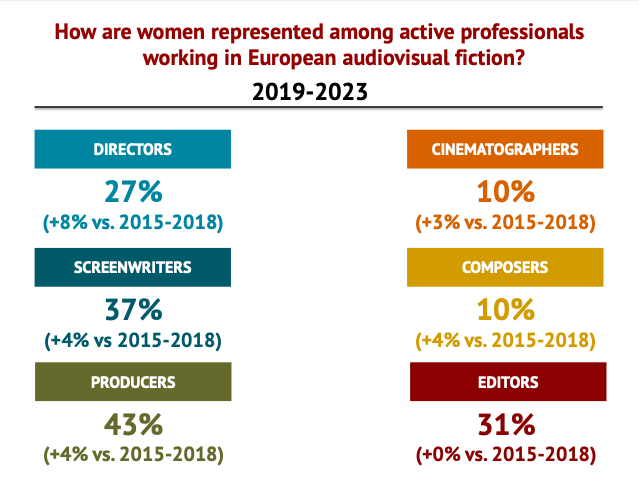Report by the European Audiovisual Observatory: 27% of Professionals in European TV Fiction Production are Women. Gender Parity by 2046?
The European Audiovisual Observatory, part of the Council of Europe in Strasbourg, published a new edition of its report “Female Professionals in European TV/SVOD Fiction Production – 2015-2023 Figures” in March. This study analyses gender inequality in the fields of directing, screenwriting, producing, cinematography, composing, and editing.
The results of the study show that between 2019 and 2023, the share of female professionals in the production of European TV and SVOD fiction was 27%, representing a modest increase of 4% compared to the period 2015–2018. The study attributes the persistence of gender inequality in the sector to three main factors: women are less frequently active in these professions, they receive fewer assignments, and they more often collaborate with others rather than working alone (e.g., female screenwriters are more likely to work in teams than their male colleagues).

The share of women differs significantly across professional roles. Female producers are the most represented group at 43%, followed by female screenwriters at 37% and editors at 31%. Female directors account for 27% of active professionals in directing, while female composers and cinematographers each represent only 10%.
Female professionals appear to be more present when roles are commonly shared among multiple people, such as in production and screenwriting teams. Conversely, women are more underrepresented in roles typically held by a single professional, such as directing or cinematography.
However, even in roles where teamwork is common, such as screenwriting and producing, teams are still predominantly male-led. For instance, between 2019 and 2023, while women were responsible for 37% of screenwriting assignments in audiovisual fiction, only 26% of screenwriting teams were led by women, compared to 59% led by men and 15% that were gender-balanced.
There has been some progress in the role of directing, with an average increase of 8% in the share of female directors between 2015–2018 and 2019–2023. However, progress in other roles has been slower: roles with already very low female representation, such as composing (+4%) and cinematography (+3%), showed only slight improvements. Similarly, roles with relatively higher female representation, like screenwriting and producing, also saw only modest increases (+4% each). The share of female editors has remained stagnant (+0%).
Despite these slight improvements, the path toward gender parity remains long. At the current pace, parity among producers could be reached by 2030, among directors by 2035, and among screenwriters by 2036. In fields such as composing and cinematography, parity might not be achieved until the mid-to-late 21st century. For editors, gender parity appears unattainable in the foreseeable future. Overall, taking all roles into account, gender parity in the production of European TV and SVOD fiction could be achieved by 2046.
There is, however, a positive finding: women in key positions significantly increase the representation of women in other creative roles. Productions led by women are more likely to have female screenwriters, producers, and other female team members. Progress in one professional field could therefore lead to broader structural changes.
Source: European Audiovisual Observatory, “Female Professionals in European TV/SVOD Fiction Production – 2015-2023 Figures”, Strasbourg, March 2025.
The study examined the share of women in directing, screenwriting, producing, cinematography, composing, and editing across European fictional TV/SVOD episodes and TV/SVOD films produced in the 27 EU member states as well as in the United Kingdom, Norway, Iceland, and Switzerland, and first broadcast or released between 2015 and 2023 (excluding series with more than 13 episodes per season).
